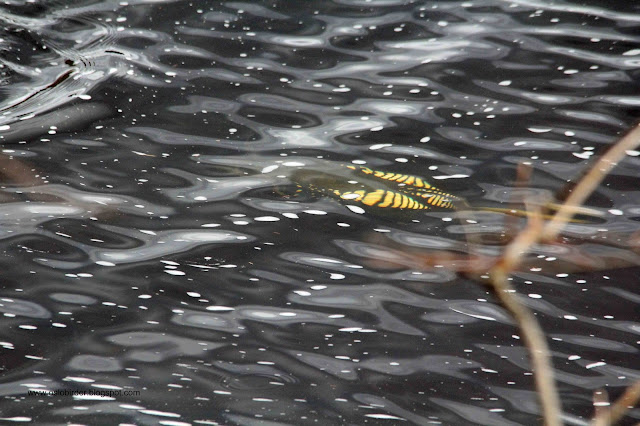It's all getting a bit too busy for blogging! The end of April
is always my favourite time and at the moment it is the movement of Teal and
other dabbling ducks that is occupying me with the never-ending searching for
something rare in their midst.
Yesterday I was at Nordre Øyeren. At this time of the year it is
usually the mighty Svellet where all the action is but the very abrupt end of
winter over the last two weeks has caused a surge of melt water with water
levels rising 45cm over the last 3 days and being now 60cm over normal levels.
This means Svellet has gone from being iced over to immediately being flooded
so conditions are pants. There is a chance that water levels will fall again
before the melt waters from the mountains start coming but all predictions are
for serious flooding this spring. The only area with any mud showing is in
Snekkervika and at the tip of Årnestangen. Fog and rain (which came too late in
the morning to force birds down) made viewing tricky but amongst at least 2000
Teal I found a pair of Garganey, a pair of Shoveler, a male Gadwall, 6 Pintail
and a 100 odd Wigeon so it was only a yank that was missing.
Wader passage hasn’t
really started but there were 40 Curlew, 7 Ringed Plover and a couple of LRPs;
things will be very different in a little over a weeks time.
Today I did the tour de
Aurskog-Høland. Here there is if anything too much flooding but conditions will
be perfect once the floods subside. There were lots of Teal to be seen here as
well but I found nothing of note amongst them despite grilling every single
one!
I had Marsh Harriers at
three localities including a nest building male, a pair of Smew at
Hellesjøvannet, my first House Martins of the year and also some waders. A few
Greenshank were to be expected alongside many Green Sandpipers but two Wood
Sandpipers were early and deserved to be grilled properly (this is a real
stringers species and the vast majority of April records (or at least 99% of
those before 20 April) will be Green Sandpipers – the earliest record ever
documented with a photo in Artsobs is 23 April.
At Fornebu yesterday I caught up
with a couple of Shore Larks that have been there for a while plus saw a ringed
Ringed Plover (in addition to 6 unringed Ringed Plovers and a Little Ringed Plover)
that had been ringed 2.8.2017 further south in Norway. My sighting of will I
hope in someway help justify the rather obscene bling it has had to carry.
In Maridalen, Willow Warblers
and Black-throated Divers have arrived and there are a few Ring Ouzels on the
fields and Teal on floodwater.
 |
| Black-throated Diver (storlom), the closest of 4 in Maridalen today |
 |
| and a pair |
 |
| this male Marsh Harrier (sivhauk) was nest building (although I did not see a female). This is 3cy male and will be breeding (or at least attempting to) for the first time |
 |
| another an much older male. The younger male has a dark trailing edge to the wing and tail and juvenile like head whereas this bird is much cleaner |
 |
| the same older male |
 |
| this female Marsh Harrier is very dark and I am unsure of age |
 |
| these 3 collared Pink-footed Geese were amongst 34 of their kin. S94 was ringed on Svalbard on 03.08.2012 and has been regularly recorded in NO, DK, NL & B since then. GA5 was ringed in mid Norway on 02.05.2017 and since then has been seen in DK & B. GH2 was ringed at the same time as GA5 (unsurprisingly as they seem to be paired) and would appear to have been seen together with him since |
 |
| pair of Smew (lappfiskand) at Hellesjøvannet. Embarassingly enough I only noticed the female on the computer.. |
 |
| male Wheatear (steinskvett) |
 |
| I'll let you decide if this counts as a record shot of a Wood Sand (grønnstilk) |
 |
| although think this one of a Greenshank (gluttsnipe) is OK |
 |
| Gadwall (snadderand) in the rain yesterday |
 |
| a/the Pied Wagtail like wagtail at Fornebu although I think it is most likely a hybrid with White |
 |
| Ring Ouzel (ringtrost) in Maridalen |
 |
| this unfortunate Ringed Plover (sandlo) received its bling on Jomfruland on 02.08.2017. It was with the breeding birds at Fornebu but I only saw it briefly and couldn't find it again so it may just have been passing through. |
 |
| crappy photo but at least educational in that it shows Ringed and Little Ringed Plover (dverglo) together |
 |
| Shore Lark (fjellerke) at Fornebu |






























































